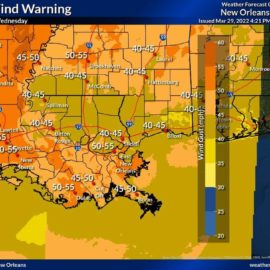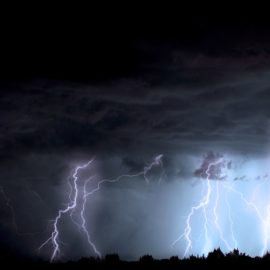
The NWS weather station in Slidell is moving to Hammond. This is to improve the reporting for Baton Rouge. What will it do to our reports?
The National Weather Service is moving a radar station crucial for storm detection in Southeast Louisiana 40 miles west from its current home in Slidell to Hammond — a step officials promise will dramatically improve storm detection in the Baton Rouge area without reducing coverage in New Orleans. By moving the radar and decreasing the angle of its beam from 0.5 degrees to 0.3 degrees, the system will be able to probe weather patterns that hover between 300 and 600 feet off the ground near Baton Rouge. Right now, the system is unable to detect storms below 4,000 feet in the Capital Region. “The improvement in what we’re going to be able to see in the atmosphere in the Baton Rouge area is going to be so dramatic that everyone is just going to have to see it for themselves,” said Ben Schott, an NWS meteorologist. “It’s going to show things people there have never seen.”
Theadvocate.com
Both cities are looking for micro-bursts and tornadoes. Does helping one hurt the other? They say no and in fact we may see a slight improvement.
Radar sampling performed lower in the atmosphere can improve identification of hazardous weather patterns that spin off from bigger storms, like tornado formations and microbursts. That has taken on greater urgency as shifting weather patterns spurred by climate change send more storms to Southeast Louisiana, heightening risk of wind and flood damage for communities in the region. Storm coverage with a lower beam over New Orleans means coverage there will be slightly better after the move, which is slated for the end of 2022, the agency said. Easy detection of brewing tornadoes and low-level winds has not been possible around Baton Rouge since the NEXRAD network — the Weather Service’s next-generation, cross-country network of 160 radars — was built in the 1990s.

The move is all about improvements and the lower viewing helps in better warnings and forecasts.
From Slidell, the radar currently emits beams over the top of the Baton Rouge region at an elevation that hovers between 5,000 and 7,000 feet, Schott said. Combined with the tiny dip in the radar’s degree, the relocation should drastically cut down on “false alarm” storm warnings the radar yields around Baton Rouge, said Schott. One example is when thunderstorms roll through. Those storms are “incredibly tall,” Schott explained, so trained meteorologists tend to make solid readings on them even when consulting radar that doesn’t scan below four-or-five-thousand feet in the sky. Sometimes, though, they get it wrong. “Fast forward to 2023 when the new radar is in Hammond and is up and running,” Schott said, “and I can see the entire thunderstorm now. I can see any little bit of rotation that could be creating a tornado. I can see high winds driving down to the surface that could create 70 to 80-plus mile-per-hour winds near the ground — things that are not certain to appear on the radar now.”
During the move, the Slidell site will be down but coverage from other sites will still give us an idea of what is in store, weather wise, daily.
The current Slidell site’s radar services will be down for three months during the move. Regional agency radars in Fort Polk; Lake Charles; Mobile, Alabama; and Jackson, Mississippi — plus a lower-powered FAA radar serving New Orleans — will fill in during that time. Once the radar is online again, the most noticeable improvements will occur in Baton Rouge, where people have tolerated false-alarm weather warnings for years. As Hurricane Laura came ashore in southwestern Louisiana last year, the weather service issued 38 tornado warnings in the area covered by the Slidell weather office, with most of them occurring in a six-hour window. Only two storms were spotted, one at Paincourtville and another at White Castle. False alarms should dissipate after the 2023 move, according to Schott. “If you live in the Baton Rouge area, what this means to you is that when the National Weather Service issues warnings for your area, you will know that they will be issued with certainty that things are actually happening,” Schott said, “because we’ll be able to see almost everything happening all the way down to the ground.”
A major improvement to Baton Rouge and a small one to New Orleans. I am glad there will be no degradation to us as we live here!



